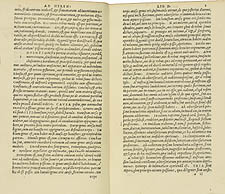Cicero. Italy, 1521
![]()
The Venetian printer Aldus Manutius (ca. 1452–1515) raised the standards
of bookmaking and had a keen sense of what the reading public wanted.
He strove to secure the best manuscripts for his editions, and he introduced
portable copies in elegant humanistic fonts for the reader’s convenience
and pleasure. The family business continued the tradition after his death,
as is seen in this edition of Cicero’s rhetorical works, published
by Aldus’s father-in-law, Andreas Torresani. In this edition, abbreviations
are scarce; while they were useful for overworked scribes, they were no
longer necessary when a book could be reproduced in a printing press.
The clear Roman font and lack of abbreviation show how, by the first decades
of the 16th century, printing was evolving beyond the manuscript model
and transforming the appearance of the written word.
![]()
Pseudo-Cicero. Rhetorica ad Herennium et al.
Venice: Aldine Press, 1521.
![]()

Copyright
© 2002 Division of Rare & Manuscript
Collections
2B Carl A. Kroch Library, Cornell University, Ithaca, NY, 14853
Phone Number: (607) 255-3530. Fax Number: (607) 255-9524
For
reference questions, send mail to:
rareref@cornell.edu
If you have questions or comments about the site, send mail to: webmaster.
